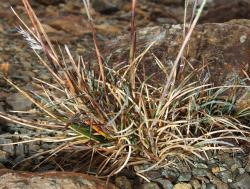- Taxon
- Gallery
Tufted shortly rhizomatous grass with pungent, stiff, thick leaf-blades much shorter than the tall smooth culmed inflorescence of ± violet suffused spikelets of long-awned, smooth, glaucous florets growing on ultramafic parent materials in South Island Dun Mountains mineral belt. Prophyll 2–3 cm, keels glabrous. Branching extravaginal. Leaf-sheath 3–4 cm, striate, glabrous or minutely antrorsely prickle-toothed, becoming red-brown and fibrous; apical auricle 0.5–1 mm, rounded, ciliate. Ligule 0.5–1 mm, erose, ciliate. Leaf-blade (6)–8–12 cm × 0.6–1.2 mm diam., conduplicate, somewhat compressed, pungent, stiff, strict or slightly curved, ribbed, glabrous, adaxially and on margins abundant short white hairs; TS: 5 vascular bundles, 7 sclerenchyma strands, exceptionally more. Culm 20–50 cm, » leaves, nodes visible, internodes glabrous, sometimes violet suffused below. Panicle narrow, 6–12–(14) cm with 4–6–(10) nodes, (12)–15–25 spikelets; basal branch ascending, 3–8 cm, solitary or binate, with 3–5 spikelets, naked below, nodes 2–5 with branches of 2–4 spikelets, uppermost 3–5 spikelets solitary, imbricate on short pedicels; rachis glabrous or glabrous below becoming prickle-toothed, branches and pedicels prickle-toothed or glabrous, often tortuous below. Spikelets 8–12–(14) mm × 3–4 mm, sometimes violet tinged, of (3)–4–5 florets. Glumes unequal, margins long ciliate below shorter above, keeled, glabrous except for a few prickle-teeth on keel, usually violet suffused centrally or throughout; lower 2.5–4.5 mm, 1-nerved, long-triangular acute, awn 0.4–0.8 mm or absent, upper 3.5–5.3 mm, 3-nerved, oblong acute, awn 0.5–3 mm abrupt or tapering or absent. Lemma 5–7 mm, lobes 0 or minute, 5-nerved, glaucous, glabrous except below awn, scarcely keeled, margin long ciliate below shorter above; awn 1.5–4.2 mm. Palea 5.5–6 mm, ≥ lemma, acute, deeply (0.3–0.5 mm) bifid, keels toothed above, interkeel hairs to base denser at apex, flank margins ciliate. Callus 0.2–0.5 mm, sparsely bearded except near rachilla, articulation ± flat to oblique. Rachilla 1–1.6 mm, densely short stiff hairy. Lodicules (0.7)–1–1.2 mm, lobed, hair-tipped or glabrous. Anthers 2–3 mm, yellow or golden. Gynoecium: ovary 0.6 mm, hispid hairs at apex or absent; stigma-styles 2 mm. Caryopsis 3.5 mm; embryo 0.5 mm; hilum = caryopsis.
[From: Edgar and Connor (2000) Flora of New Zealand. Volume 5 (second printing).]




